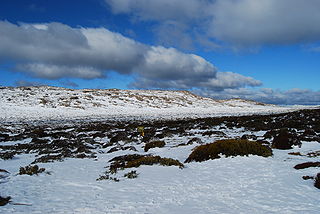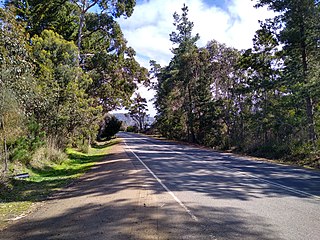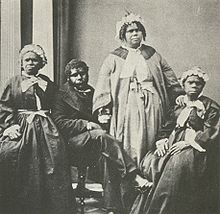
Tasmania is an island state of Australia. It is located 240 kilometres to the south of the Australian mainland, and is separated from it by the Bass Strait. The state encompasses the main island of Tasmania, the 26th-largest island in the world, and the surrounding 1000 islands. It is Australia's smallest and least populous state, with 573,479 residents as of June 2023. The state capital and largest city is Hobart, with around 40% of the population living in the Greater Hobart area. Tasmania is the most decentralised state in Australia, with the lowest proportion of its residents living within its capital city.

Truganini, also known as Lalla Rookh and Lydgugee, was a woman famous for being widely described as the last "full-blooded" Aboriginal Tasmanian to survive British colonisation. Although she was one of the last speakers of the Indigenous Tasmanian languages, Truganini was not the last Aboriginal Tasmanian.

George Augustus Robinson was an English born builder and self-trained preacher who was employed by the British colonial authorities to conciliate the Indigenous Australians of Van Diemen's Land and the Port Phillip District to the process of British invasion and colonialisation.

Truganina is a suburb in Melbourne, Victoria, Australia, 22.4 km (13.9 mi) west of Melbourne's Central Business District, located within the Cities of Melton and Wyndham local government areas. Truganina recorded a population of 36,305 at the 2021 census.

The Tasmanian languages were the languages indigenous to the island of Tasmania, used by Aboriginal Tasmanians. The languages were last used for daily communication in the 1830s, although the terminal speaker, Fanny Cochrane Smith, survived until 1905.

Mount Nelson is a mountain suburb located on the southern boundary of the city of Hobart, Tasmania, Australia. Positioned to the south of Hobart's CBD, Mount Nelson varies in elevation with its summit reaching 351 metres (1,152 ft) above sea level, offering panoramic views of the scenic Derwent estuary and surrounds.

Ben Lomond is a mountain in the north-east of Tasmania, Australia.
Palawa kani is a constructed language created by the Tasmanian Aboriginal Centre as a composite Tasmanian language, based on reconstructed vocabulary from the limited accounts of the various languages once spoken by the Aboriginal people of what is now Tasmania.

Michael Alexander Mansell is a Tasmanian Aboriginal (Palawa) activist and lawyer who has campaigned for social, political and legal changes.

Doctor Wooreddy's Prescription for Enduring the Ending of the World is an historical novel by Mudrooroo Nyoongah, first published in 1983. A tragedy, the work explores the reaction of Aboriginal Tasmanians to European colonisation during the nineteenth century. It has several characters based on real-life historical figures, including Truganini, George Augustus Robinson, and Governor George Arthur.

Eastern Tasmanian is an aboriginal language family of Tasmania in the reconstructed classification of Claire Bowern.
Northeastern Tasmanian, or Pyemmairre, is an Aboriginal language of Tasmania.
Oyster Cove is a semi-rural locality in the local government areas (LGA) of Kingborough and Huon Valley in the Hobart and South-east LGA regions of Tasmania. The locality is about 20 kilometres (12 mi) south-west of the town of Kingston. The 2016 census has a population of 319 for the state suburb of Oyster Cove. Part of Oyster Cove is an Indigenous Protected Area due to its history as a colonial holding facility for Aboriginal Tasmanians.

Luggenemenener was an early nineteenth-century Tasmanian Aboriginal woman, who lived in the early 1800s. She endured the Black Wars and risked her life to protect her young son from a genocide of her people. Her homeland was in north-east Tasmania's Ben Lomond region. According to the French explorer Nicolas Baudin, Tasmania was originally known as Lutruwita.

Tunnerminnerwait (c.1812–1842) was an Australian Aboriginal resistance fighter and Parperloihener clansman from Tasmania. He was also known by several other names including Pevay, Jack of Cape Grim, Tunninerpareway and renamed Jack Napoleon Tarraparrura by George Robinson.
Lucy Beeton was an Aboriginal Tasmanian schoolteacher, trader and Christian leader.

Great Bay is a rural locality on Bruny Island in the local government area of Kingborough in the Hobart region of Tasmania. It is located about 18 kilometres (11 mi) north-east of the town of Alonnah, the largest town on the island. The 2016 census determined a population of 57 for the state suburb of Great Bay. The Bruny Island Airport is located within the suburb of Great Bay.

Kikatapula was a leading Indigenous figure during the British invasion and colonisation of Van Diemen's Land, later known as Tasmania. Also called Kickerterpoller or Black Tom Birch, he spent part of his youth living with the colonists, learning English and being baptised as a Christian. During the 1820s, he withdrew from British ways, and became a feared and formidable leader of Indigenous resistance during the early stages of the Black War.

The Wybalenna Aboriginal Establishment was an internment facility built at Flinders Island by the colonial British government of Van Diemen's Land to accommodate forcibly exiled Aboriginal Tasmanians (Palawa). It was opened in 1833 and ceased operations in 1847. During that period around 180 Palawa were situated at Wybalenna with approximately 130 people dying at the establishment. Around another 25 died while being transported to the facility. The main commandant of Wybalenna was George Augustus Robinson who played a principal role in the system of capturing and sending Palawa to the facility. Famous people incarcerated at Wybalenna included Truganini, Mannalargenna and William Lanne, amongst others. Due to the many deaths of Indigenous people at Wybalenna, the alienation of the inmates from their homeland and the forcible repression of cultural practices, the Wybalenna establishment is regarded as an example of the implementation of genocidal policies against Indigenous Australians.

Woureddy, also known as Wurati, Woorady and Mutteelee, was a leading warrior and cleverman from the Nuenonne clan of Aboriginal Tasmanians in Australia.
















